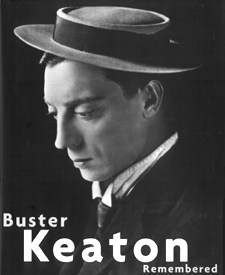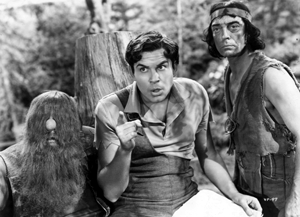Buster Keaton Remembered, a new book, gives insight into this genius that has inspired, and is still inspiring, animation's greats. Will Ryan reviews.

This is a book to read! This is a book to see! It's a book to have, it's a book to give. It will inspire, it will amaze. If you don't have a coffee table, it's worth getting one just to put this book on top of it.
For someone who, as far as I have been able to discern, never directly participated in the medium, Buster Keaton is a key figure in the development of animation. He was a direct inspiration for some of the finest artists in the field. His influence on Walt Disney and his studio are obvious.
Included in this book's 240 pages are 225 photographs chosen from thousands of images of Buster -- family photos and film stills -- and many from the original 8x10 negatives. As Manoah Bowman points out in his notes on the photography, "...[S]ome of the most famous stills of Keaton were cartoonish 'gag' shots that did not even appear in the films they were supposedly representing. For example, two of the most instantly recognizable photographs of Keaton from The Navigator (Keaton sitting stoically on the steamship, and Keaton hanging off the rigging ropes looking out at the sea) are nowhere to be found in the film."
Keaton's use of publicity "gag" shots was picked up by the Disney studios in their use of special publicity artwork for individual cartoons. A picture can be worth a thousand words, or maybe sell a thousand tickets. Mickey Mouse's first starring release, Steamboat Willie (released November 18, 1928), was a clear pun on Keaton's recent (May 12, 1928) success Steamboat Bill Jr. Moreover, Buster meets Mickey Mouse in one of Mickey's earliest cartoons. Buster's films were screened regularly to "inspire" the animators and gag men at the studio. The "borrowing" of gags or ideas was inevitable.

Buster guest-stars as an animated character in cartoons for other studios, too. He played a cartoon character in the first Li'l Abner feature film. And of course he began his career as a living cartoon. The family act, The Three Keatons, consisted of knock-about, grotesque caricatures of shanty Irish -- right out of the funny pages. They presaged Happy Hooligan and Jiggs and Maggie, who later went on to star in animated cartoons.
And speaking of funny pages, here's a conundrum for the ages: Which Buster came first, the Keaton or the Brown?
Buster was responsible for making a film actor out of an East Coast mug named Edward Brophy, who went on to create the voice of Timothy Mouse, famed sidekick of Dumbo. Buster was longtime pals with fellow ukulele strummer Cliff Edwards. They were in three feature films together including one shot primarily in Buster's Beverly Hills home! Cliff went on to create the voices of Jiminy Cricket and another Dumbo sidekick, Jim Crow (if that's still the character's name). Buster's co-star in his early talkies was Jimmy Durante, who later famously hosted (as an animated figure) a Rankin-Bass stop-motion perennial.
As a comedy technician whose very body was a prop for humor, Buster Keaton reigns supreme. Only Lupino Lane approached him as an acrobatic comedy star. Even after over 100 years of cinema, no one has come close to mastering the physics and geometry of cinematic comedy in live-action. In animation, I would argue that Chuck Jones together with Mike Maltese and Maurice Noble and other collaborators approximate the template set by Buster, particularly in the Roadrunner cartoons. The cerebral, surreal quality of Buster's battle with real life's frustrations is reflected in the Coyote's obsessive pursuit of the elusive.
While drawing a picture at his home one day, Chuck said to me, "You know, one thing about Buster Keaton: he acted with his feet." Okay: I was stumped. "What do you mean?" Without looking up from his drawing, the great cartoon director explained. "Well, he doesn't act with his face. It never moves. So he acts with his feet. If he's confused by something, he walks up to it, maybe takes a few steps back. Might even walk around it. No expression on his face, so he acts with his feet." Hmmm. This guy has thought about Buster Keaton a lot. And it shows in his work.
The text of this book is as outstanding as the visuals. Included are reminiscences by Buster's widow, the late Eleanor Keaton, a filmography, Eleanor's famous recipe for baking a pork-pie hat, an afterword by British film historian Kevin Brownlow and essays on each of Buster's greatest films and on every stage of his career.

There was once a book, translated from the French, called The Look of Buster Keaton. It consisted of many photographic portraits and running commentary praising the "beauty" of Buster's face. The commentary seemed at odds with the 40 miles of bad road the public was confronted with on Buster's later television appearances (Twilight Zone, Ed Sullivan, etc.) and in films (all those American International pictures). But the book managed to confirm with photographic evidence its contention. Not unlike Japanese puppets whose faces are immobile masks, Buster's face in his early films reflects and emits mystery, profundity and a vaguely surreal transcendence, which might indeed be described as beauty. Whatever its qualities, that earlier book lacked the impressive packaging and pedigree of the book currently under review.
Buster Keaton Remembered should be on the shelves of all the animation professionals who frequent the Buster Keaton screenings at the Silent Movie Theatre on Fairfax in Los Angeles. Based on my visits to such screenings, that's a sizeable percentage of the people in the L.A. business.
It would have been nice had Eleanor Keaton lived to see this completed book. But Buster's widow passed away as the book was well along in production. Buster Keaton Remembered is a labor of love. It memorializes Buster Keaton in a way that would please Marc Antony. It works in the way that memory works for the luckiest of us: the bad parts are skimmed over or ignored and the very best remains vivid and alive.
Buster Keaton Remembered by Eleanor Keaton and Jeffrey Vance. New York, NY: Harry N. Abrams, Inc., 2001. 225 black-and-white photographs, 238 pages. isbn: 0-8109-4227-5 (us$45.00/can$65.00)
Will Ryan was a friend of the late Eleanor Keaton. This was perhaps because, despite or regardless of the fact that he plays the ukulele. He has received Emmy and Writer's Guild Award nominations for his work as a writer/producer. Among his current projects are the Annie Award-winning series Elmo Aardvark: Outer Space Detective! and the screenplay for Murder In Malibu.







